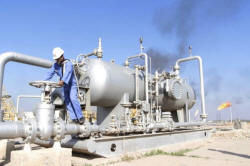Oil gains as Forties outage, Nigeria strike threaten
supply
 Send a link to a friend
Send a link to a friend
 [December 18, 2017]
By Libby George [December 18, 2017]
By Libby George
LONDON (Reuters) - Oil price edged higher
on Monday, supported by a North Sea pipeline outage and a Nigerian oil
worker strike.
A fall in the number of U.S. rigs drilling for oil also underpinned
prices, but growth in U.S. crude output cast a shadow over the market.
Brent crude futures <LCOc1>, the international benchmark, were at $63.37
a barrel at 1203 GMT, up 14 cents from their last close.
U.S. West Texas Intermediate crude futures <CLc1> were at $57.49 a
barrel, up 19 cents.
The Brent benchmark had traded as high as $63.91 earlier in the day, but
the contract pared gains after Ineos, the operator of the closed North
Sea Forties pipeline, said the crack that shut it down had not spread.

The 450,000-barrels-per-day (bpd) link that provides some of the
physical crude underpinning Brent has been shut since Dec. 11, forcing
Ineos to declare force majeure on all oil and gas shipments from it last
week.
"The declaration of force majeure highlights the seriousness of this,"
said Bjarne Schieldrop, chief commodities analyst with SEB in Oslo,
adding that any extension of the outage could further boost prices.
A strike by Nigerian oil workers also sparked concerns over exports from
Africa's largest crude producer.
The Petroleum and Natural Gas Senior Staff Association of Nigeria, whose
members mainly work in the upstream oil industry, started industrial
action on Monday after talks with government agencies ended in deadlock.
[to top of second column] |

A worker checks the
valve of an oil pipe at Nahr Bin Umar oil field, north of Basra,
Iraq December 21, 2015. REUTERS/Essam Al-Sudani/File Photo

In the United States, energy companies cut rigs drilling for new production for
the first time in six weeks, to 747, in the week ended Dec. 15, energy services
firm Baker Hughes said on Friday.
Despite the dip in drilling, activity is still well above this time last year,
when the rig count was below 500. Actual U.S. production <C-OUT-T-EIA> has
soared by 16 percent since mid-2016 to 9.8 million bpd.
U.S. output is fast approaching that of top producers Saudi Arabia and Russia,
which are pumping 10 million bpd and 11 million bpd respectively.
This has undermined market-balancing efforts by the Organization of the
Petroleum Exporting Countries and a group of non-OPEC producers including Russia
to withhold production.
Largely because of rising U.S. shale output, the International Energy Agency
said global oil markets would show a supply surplus of around 200,000 bpd in the
first half of 2018.
The U.S. Energy Information Administration showed a similar surplus for that
period and indicated a supply overhang of 167,000 bpd for all of 2018.
(Additional reporting by Henning Gloystein in Singapore; Editing by Dale Hudson
and David Evans)
[© 2017 Thomson Reuters. All rights
reserved.] Copyright 2017 Reuters. All rights reserved. This material may not be published,
broadcast, rewritten or redistributed. |